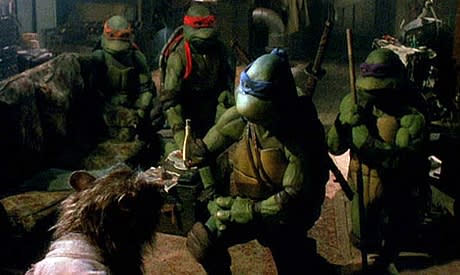Even in its time, the original Teenage Mutant Ninja Turtles movie was visibly dated. It was independently financed, going on to become the highest grossing independent film of all time when it was released, which was both an anomaly for the early '90s as well as a problem for a work rooted ostensibly in an aesthetic high concept comic book environment.
Director Steve Barron attempted to ground the work in its original roots, using a grungy New York City backdrop as an increasingly corrupt stomping ground for West meets East ideological and stylistic battle. This helped, in part, with budgetary limitations, since making everything dirty and ugly is far easier than the increasingly cartoonish dynamic of the Turtle sequels.
And while the action was lethargic and the puppet work embarrassing, the mixing of goofy elements from the cartoon—and helpful aspects, like the inclusion of April O'Neal (Judith Hoag) as a reporter and the distinction of colour in bandanas—with the darker comic dynamic did appeal to those familiar with the franchise (chiefly: kids).
The story was kept simple, leveraging the standard Conservative anxieties of the masses—working single parents leads to hoodlum thug children (led by Sam Rockwell)—to make relevant the story of four mutant turtles—conflicted Rafael; uptight Leonardo; dippy Donatello; and party animal Michaelangelo—and their aging mutant rat sensei, Splinter.
Noticing an increase in unrelated, peculiar crimes throughout the city, the gang teams up with reporter April O'Neal and renegade crime fighter Casey Jones (Elias Koteas, who wears a jockstrap under jogging pants for the entire movie) to fight a gang of ninja-fighting foot soldiers. Since they've targeted O'Neal for her reports and connection to the turtles, an abundance of cartoonish fight sequences abound, with more realistic than usual outcomes for a film that features pizza-eating turtles that say things like "tubular" and "gnarly."
While the villain—and his background connection to Splinter—are (and were) clear to the viewing audience familiar with the franchise, the original story backdrop makes Shredder's big reveal a bit of a third arc twist. In a modern context, it's little more than formulaic cheese presented with the subtlety of a video game cut screen, not unlike the highly popular TMNT side-scrolling Double Dragon-like arcade game at the time of release. But, despite its budgetary limitations and virtually non-existent visual palette, Teenage Mutant Ninja Turtles was a reasonably faithful adaptation of the source material, capturing a tone that vacillates between dark and corny.
Teenage Mutant Ninja Turtles screens at the TIFF Bell Lightbox as part of the Comic Book Heroes retrospective at 1pm on March 22nd, 2013.
(New Line)Director Steve Barron attempted to ground the work in its original roots, using a grungy New York City backdrop as an increasingly corrupt stomping ground for West meets East ideological and stylistic battle. This helped, in part, with budgetary limitations, since making everything dirty and ugly is far easier than the increasingly cartoonish dynamic of the Turtle sequels.
And while the action was lethargic and the puppet work embarrassing, the mixing of goofy elements from the cartoon—and helpful aspects, like the inclusion of April O'Neal (Judith Hoag) as a reporter and the distinction of colour in bandanas—with the darker comic dynamic did appeal to those familiar with the franchise (chiefly: kids).
The story was kept simple, leveraging the standard Conservative anxieties of the masses—working single parents leads to hoodlum thug children (led by Sam Rockwell)—to make relevant the story of four mutant turtles—conflicted Rafael; uptight Leonardo; dippy Donatello; and party animal Michaelangelo—and their aging mutant rat sensei, Splinter.
Noticing an increase in unrelated, peculiar crimes throughout the city, the gang teams up with reporter April O'Neal and renegade crime fighter Casey Jones (Elias Koteas, who wears a jockstrap under jogging pants for the entire movie) to fight a gang of ninja-fighting foot soldiers. Since they've targeted O'Neal for her reports and connection to the turtles, an abundance of cartoonish fight sequences abound, with more realistic than usual outcomes for a film that features pizza-eating turtles that say things like "tubular" and "gnarly."
While the villain—and his background connection to Splinter—are (and were) clear to the viewing audience familiar with the franchise, the original story backdrop makes Shredder's big reveal a bit of a third arc twist. In a modern context, it's little more than formulaic cheese presented with the subtlety of a video game cut screen, not unlike the highly popular TMNT side-scrolling Double Dragon-like arcade game at the time of release. But, despite its budgetary limitations and virtually non-existent visual palette, Teenage Mutant Ninja Turtles was a reasonably faithful adaptation of the source material, capturing a tone that vacillates between dark and corny.
Teenage Mutant Ninja Turtles screens at the TIFF Bell Lightbox as part of the Comic Book Heroes retrospective at 1pm on March 22nd, 2013.
